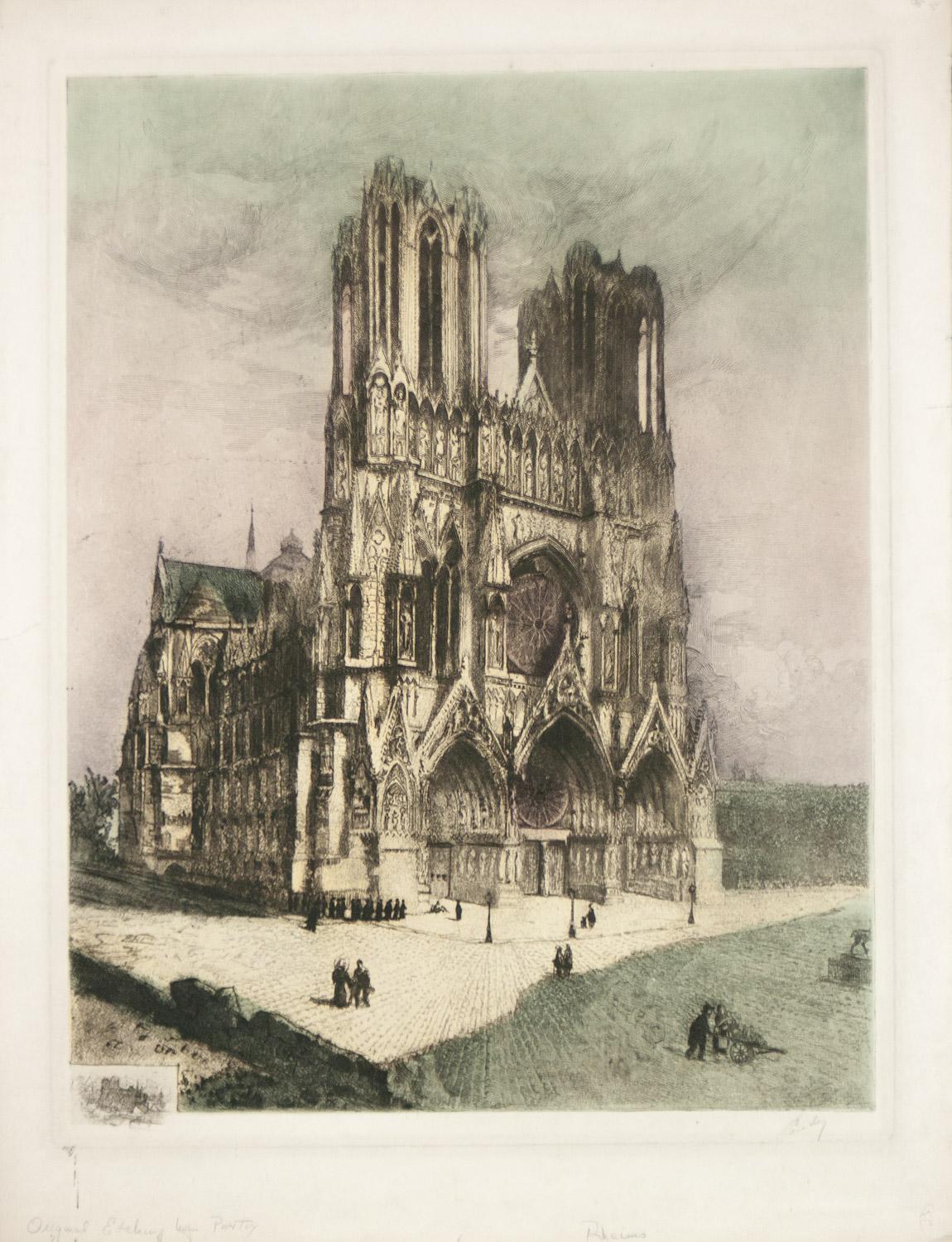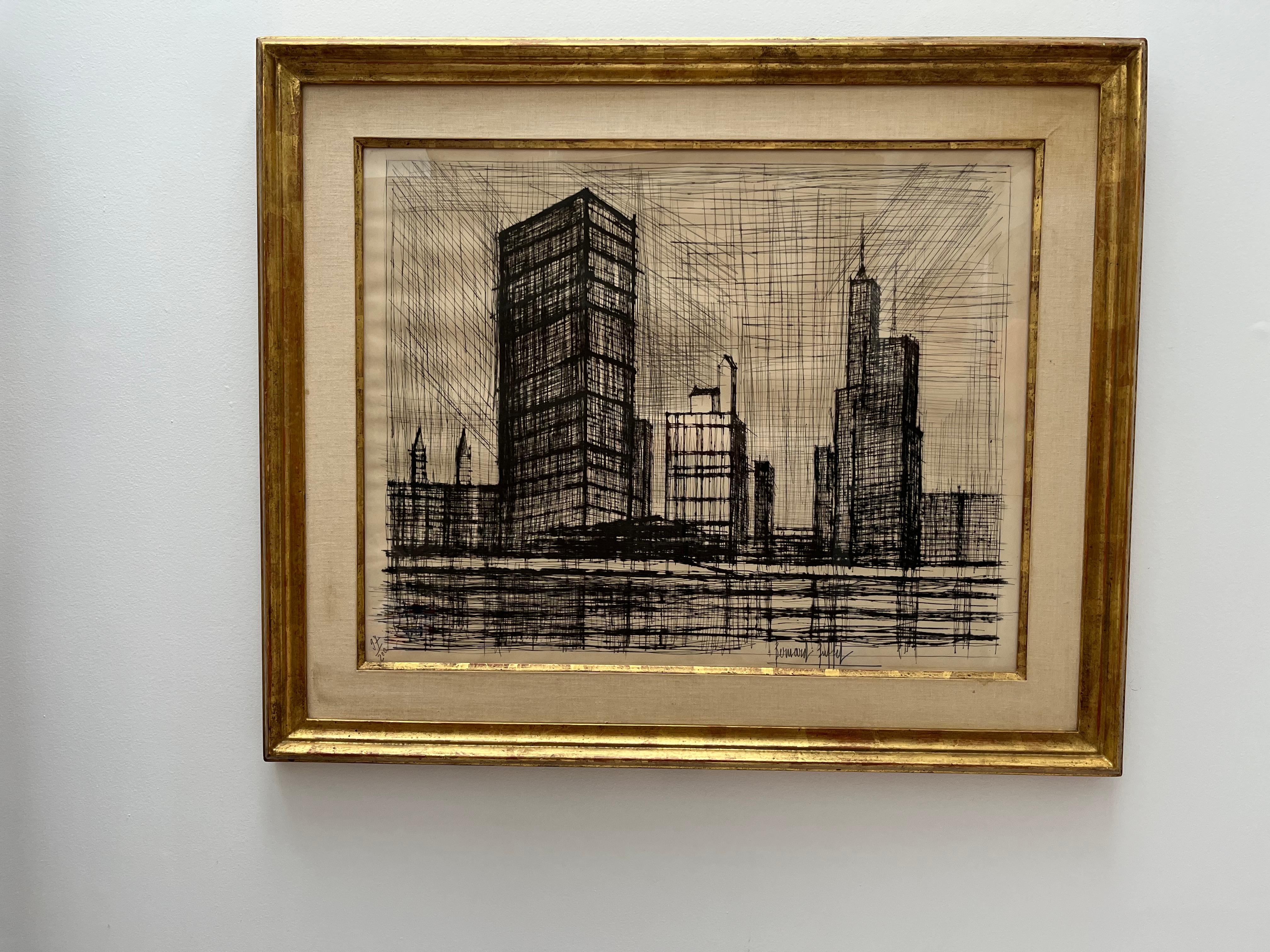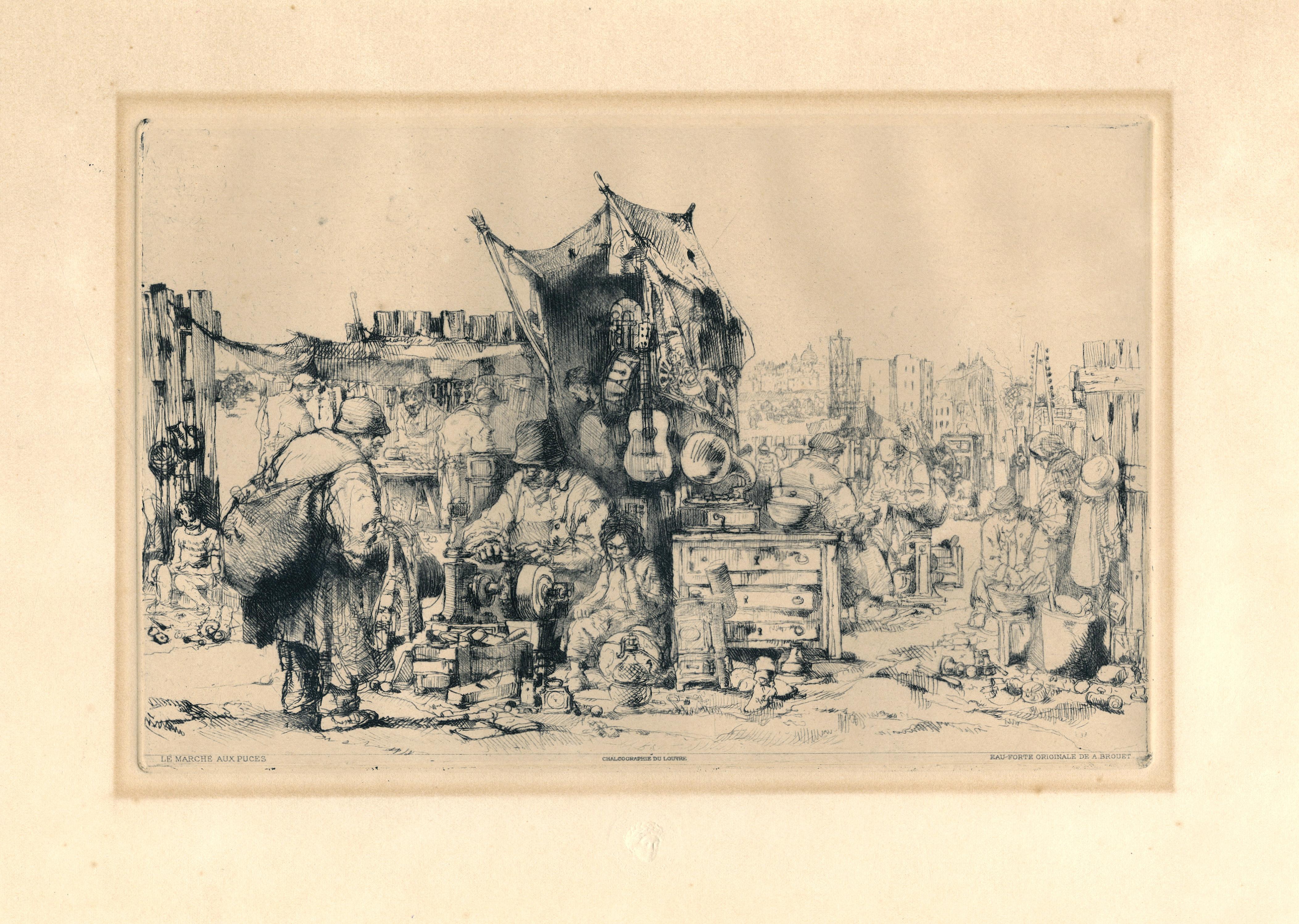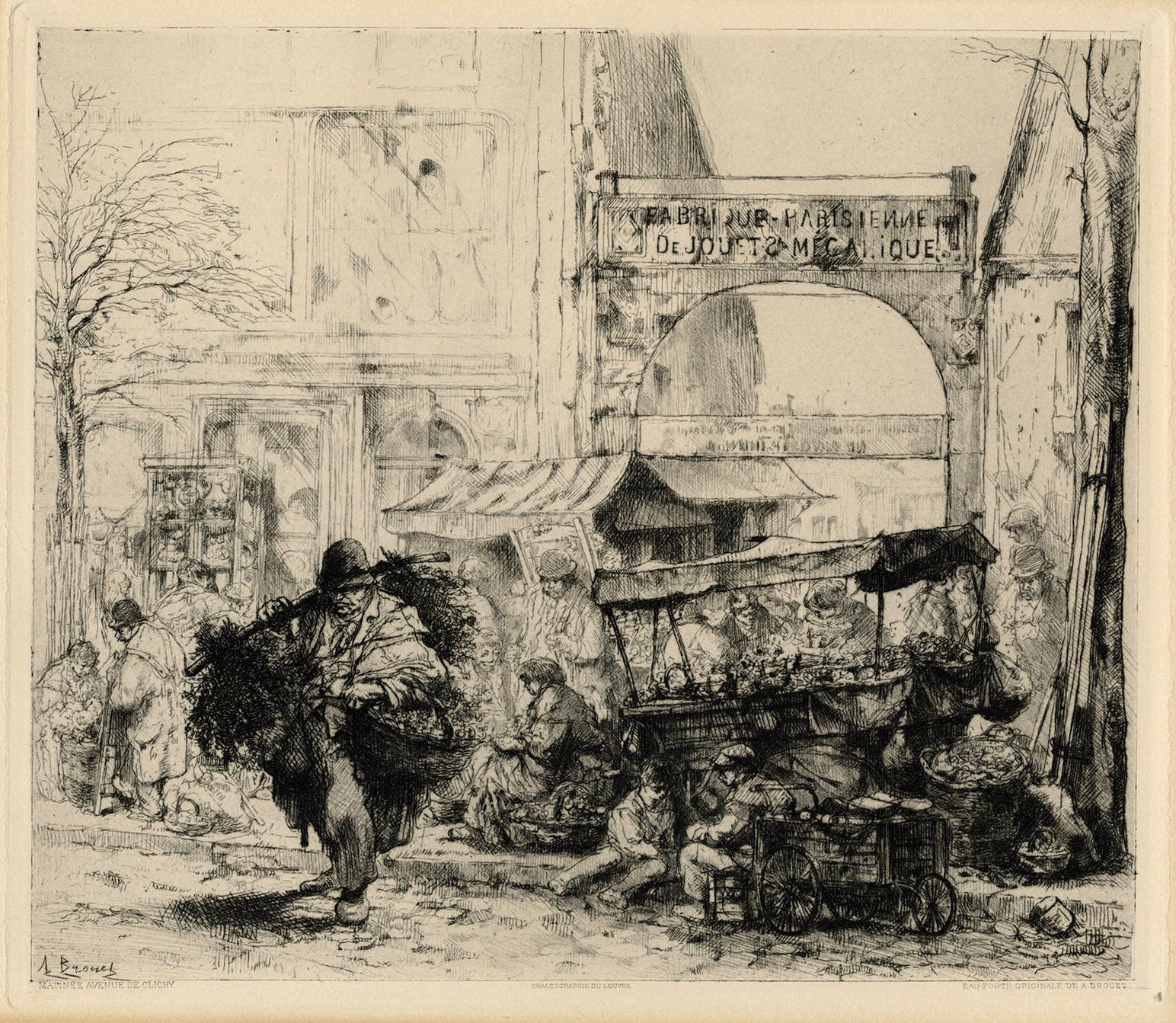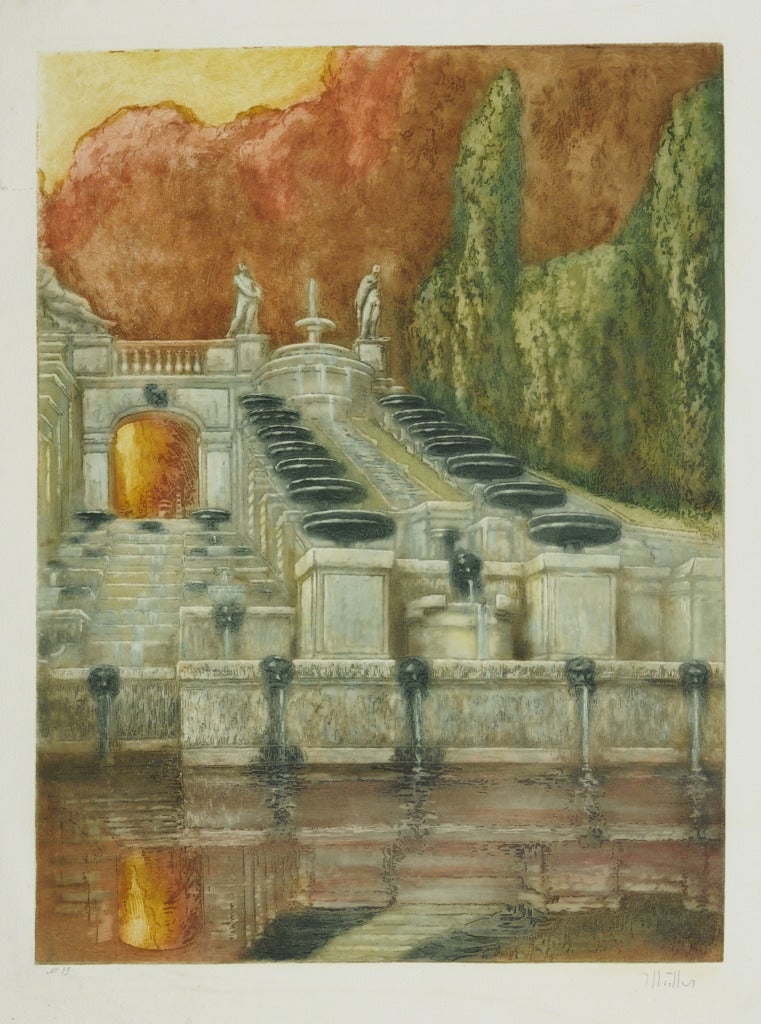Items Similar to untitled (Fishing Boats, Normandy)
Want more images or videos?
Request additional images or videos from the seller
1 of 10
Kamesuke Hiragauntitled (Fishing Boats, Normandy)1930
1930
About the Item
untitled (Fishing Boats, Normandy)
Soft Ground Etching, 1930
Signed and dated in pencil by the artist
Sealed by the artist
Annotated "Paris"
Possibly a view of a fishing port in Normandy
Intended edition of 25, per numbering.
No other impression of this image can be found on the web.
Condition: Good. Printed on japanese paper, mounted to French artist board as support. Most probbably done at the time of printing.
Irregular margins on bottom edge
Plate size: 11-7/8 x 15-1/2 inches
Sheet size: 15 1/4 x 19.5/8 inches
Born in Tokyo, Japan in 1889. Hiraga arrived in post-earthquake San Francisco in 1907 and studied at the Institute of Art for five years. He then moved to Los Angeles. While a resident there, he won the Julian prize in 1914 to study in Paris, and went again in 1925 to study painting under Lucien Simon. He was active in Los Angeles into the 1930s. Breaking away from traditional Japanese printmaking form, Kamesuke Hiraga was just a teenager when he left Shima to study painting at the San Francisco Art College in 1906. Later moving to Paris, Hiraga studied printmaking at the Ecole des Beaux-Arts where, in 1915, he became the first Japanese student to win the Grand Prize. Spending much of his life in both Europe and America, Hiraga made use of his undeniable talent for painting and printmaking to demonstrate his fascination with the people and the landscapes of his travels. Yet, despite his foreign training, there is something of his own rich heritage of printmaking that shines through in Hiraga’s unique approach to soft ground etching. Exh: Pasadena Paris Salon, 1925; Society of Artists, 1931; Pasadena Art Inst., 1931. He died in Hamajima, Japan in 1971. Combinations of mastery and personal style are what make certain artists highly collectable long after their time. Still popular in France, Hiraga’s work hangs in the famous Georges Pompidou Centre in Paris. Not forgotten at home, his work is featured in the Bridgestone Museum of Art, Japan. And, as recently as 2006, to commemorate the hundredth anniversary of Kamesuke Hiraga’s journey to America, his paintings and prints were displayed at a special exhibition at Jingu Chokokan Museum, Ise.
- Creator:Kamesuke Hiraga (1889 - 1971, Japanese)
- Creation Year:1930
- Dimensions:Height: 11.88 in (30.18 cm)Width: 15.5 in (39.37 cm)
- Medium:
- Movement & Style:
- Period:
- Condition:
- Gallery Location:Fairlawn, OH
- Reference Number:
About the Seller
5.0
Recognized Seller
These prestigious sellers are industry leaders and represent the highest echelon for item quality and design.
Platinum Seller
These expertly vetted sellers are 1stDibs' most experienced sellers and are rated highest by our customers.
Established in 1978
1stDibs seller since 2013
713 sales on 1stDibs
Typical response time: 1 hour
Associations
International Fine Print Dealers Association
- ShippingRetrieving quote...Ships From: Fairlawn, OH
- Return PolicyA return for this item may be initiated within 10 days of delivery.
More From This SellerView All
- La Grande Cascade de Saint CloudBy Alfredo MüllerLocated in Fairlawn, OHLa Grande Cascade de Saint Cloud Color aquatint on watermarked Arches J Perrigot paper, 1905 Signed by the artist in pencil lower right. (see photo) Edition: 100. Numbered "39" in pencil lower left. Titled in pencil verso Published by Edmund Sagot, Paris, his dry stamp lower right below signature. Image: 23-1/8 x 17-3/8" (58.7 x 44 cm.) From the British Museum: "Colour etcher. Born in Livorno from a family of wealthy Swiss cotton merchants, studied with Giuseppe Ciaranfi and Michele Gordigiani in Florence. In 1886 exhibited with Fattori, Achille Lega and Tommasi in the Prima Esposizione delle Belle Arti in Livorno. In 1888 he and his family moved to Paris, where he studied first with François Flameng until 1892 and later with Carolus-Duran. Müller remained in the French capital until the outbreak of the First World War, taking French citizenship in 1913. He worked in the countryside at Barbizon, Suresnes and elsewhere, but also made frequent visits to his native country, where he exhibited regularly in Florence with the Promotrice Fiorentine. His early work was indebted to Fattori and Plinio Nomellini, but he soon became interested in the Impressionists and was credited by the critic Mario Tinti with introducing the luminism of Monet into Italian art. Müller was a member of the Société des Artistes Indépendents and exhibited regularly in the Paris dealer George Petit's annual exhibitions of colour prints. He made his first print in 1896, a lithographic portrait of the poet Paul Verlaine in the Café Procope. The following year Müller made his first colour aquatints. Among them were a series of illustrations to Dante's Divine Comedy. In style his etchings and aquatints were influenced by Manuel Robbe. Very occasionally he combined drypoint or soft ground etching with aquatint. Müller's principal publisher was Pierrefort, who also issued prints by Toulouse-Lautrec. After 1903 he largely abandoned aquatint for pure etching. Fourteen of his colour etchings were reproduced over a number of months in the weekly magazine 'Le Courrier français'. Müller also made a small number of colour lithographs, some of which were published by the Parisian print dealer Sagot. A single monotype of Mallarmé done in 1911, thirteen years after the poet's death in 1898, is recorded. Müller made a few landscape prints and a couple of etchings of fishing boats, but his principal subject was young women in long dresses. Often there is an aura of fin-de-siècle wistfulness. When he returned to Italy, he lived first in Taormina, then in Florence, and finally settled in a villa at Settignano. Müller largely abandoned printmaking after 1914. Only three more prints by him made in 1920, 1925 and 1933 are recorded after he moved back to his native country. Müller was a regular exhibitor in Florentine exhibitions, the most significant of which was the 1922 Primaverile Fiorentina. He returned to France in 1930 where he died in 1939. (Text by Martin Hopkinson)" Said to rival the fountains at Versailles, La Grande Cascade is still turned on for a few hours every Sunday in June. The Grande Cascade, constructed in 1664-1665 by Antoine Le Pautre has survived. The château was expanded by Phillipe de France, duc d'Orléans in the 17th century, and finally enlarged by Marie Antoinette in the 1780s. Napoleon I and Napoleon III also used the palace, which was a U-shaped scheme of three sections, open to the east. Destroyed by fire (with the exception of a few outbuildings and its majestic garden) in 1870, during the Franco-Prussian War. The burned-out shell stood until 1891, when it was demolished. The gardens were replanned by André Le Nôtre...Category
Early 1900s French School Prints and Multiples
MaterialsAquatint
- L’Angelus (The Bell Tower)By Félix Hilaire BuhotLocated in Fairlawn, OHL’Angelus (The Bell Tower) etching & drypoint, c. 1876 Signed in the plate with the artist's initials (see photo) Condition: Excellent Image/Plate size: 5 7/8 x 4 1/4 inches Sheet s...Category
1870s French School Landscape Prints
MaterialsEtching
- Westminster PalaceBy Félix Hilaire BuhotLocated in Fairlawn, OHWestminster Palace Etching, Drypoint, Aquatint, roulette and salt ground lift 1884 Depicts the Houses of Parliament, Big Ben Clock and Tower and the River Thames in the foreground. S...Category
1880s French School Landscape Prints
MaterialsEtching
- Night Life at the Moulin RougeBy Henry SommLocated in Fairlawn, OHNight Life at the Moulin Rouge Pen and ink drawing, c. 1890 Signed lower left (see photo) A scene of the night life near the Moulin Rouge, Paris. The Moulin Rouge is the famous cabaret located in the old wind mill building in the right distance of this image. It was the center of fin de siecle culture in Paris. Condition: Slight yellowing to the sheet from age. Sight size: 9 x 5 3/4 inches Frame size: 14-1/8 x 10-3/4 x 1/2" Provenance: Eric G. Carlson (1940-2016), art historian and noted art dealer François Clément Sommier, best known under the pseudonym “Henry Somm,” was born in Rouen in 1844. He attended the local École municipale des beaux-arts and went on in 1867 to Paris, where he studied under Isidore Pils (1813-1875). “Somm is above all a painter and his watercolors are much sought after; he has the painter’s eye to the highest degree imaginable.” Louis Morin, Somm’s fellow artist revealed in 1893 that while his training as an academic painter forged his draughsmanship and an acute eye for colors, Somm preferred and excelled in the graphic realm. Particularly prolific, he produced a very extensive corpus of 7,500 drawings and prints, many of which were widely reproduced in journals and magazines. In 1867, Somm’s career reached a turning point with the discovery of Japanese culture through his friendship with French collector and critic Philippe Burty and a visit to the Paris International Exhibition. More generally, Japanese art and especially Japanese woodblock prints exerted a heavy influence on French artists at the time, and especially on the Impressionists, who were particularly inspired by the subject matter, as well as the innovative use of perspective, composition and color. Although technically not an Impressionist by pure definition, Somm’s interest in the effect of atmospheric light on shadow and color prompted Edgar Degas to invite him to participate in their 4th exhibition in 1879. However, Somm did not exhibit again with the Impressionists, and was never considered a member of the group. Rather, his work intersects between Impressionism, Symbolism and Japonism. In fact, while his drypoints and etchings reflect a more literal borrowing of Japanese elements than the work of Whistler or Monet, they also clearly anticipate the future work of Henri de Toulouse-Lautrec. Although Somm was 20 years older than Toulouse-Lautrec, both artists developed a friendship, as habitués of the Chat noir, a cabaret founded by Rodolphe Salis and located 84 boulevard de Rochechouart in Montmartre. More than a cabaret, the Chat noir also became an important gathering place for writers, poets, composers, musicians, and artists living in Montmartre. For Somm, a founding member of this artistic circle, it also served as a unique environment, where he could express his limitless imagination as active participant to the events – notably the literary soirées organized by the hydropathic group – and illustrator of the Chat noir journal. In 1886, Somm, in collaboration with Georges Auriol, initiated the Chat noir’s first puppet show, which subsequently evolved into shadow theater. Somm’s Japonism and sense of humor appealed to Toulouse-Lautrec, and this influence is echoed in Lautrec posters advertising two other Montmartre nightspots, namely Le Mirliton and Le Divan Japonais...Category
Late 19th Century French School Drawings and Watercolor Paintings
MaterialsInk
- Dejeuner sur l'HerbeBy After Paul CezanneLocated in Fairlawn, OHDejeuner sur l'Herbe Lithograph, c. 1914 Edition: c. 100 Unsigned as issued by Vollard References And Exhibitions: Commissioned from Cezanne by Ambrose Vollard in the late 1890s Prin...Category
1910s French School Landscape Prints
MaterialsLithograph
- A L'Ombre (In Shadow)By Louis LegrandLocated in Fairlawn, OHA L'Ombre (In Shadow) Etching & drypoint, 1905 Signed with the red stamp of the publisher Pellet (see photo) Edition: 50 on velin paper, signed and numbered Publisher: Gustav Pellet, Paris (his red stamp lower right, recto; Lugt 1193) Condition: Excellent Image/Plate size: 5-7/8 x 8-5/8" (14.8 x 21.8 cm.) Sheet size: 11 5/8 x 17 1/8" Reference: IFF 119 Exteens 229 Arwas 256 v/V Louis Auguste Mathieu Legrand (29 September 1863 – 1951) was a French artist, known especially for his aquatint engravings, which were sometimes erotic. He was awarded the Légion d'honneur for his work in 1906. Life Legrand was born in the city of Dijon in the east of France. He worked as a bank clerk before deciding to study art part-time at Dijon's Ecole des Beaux-Arts. He won the Devosge prize at the school in 1883.[2] In 1884 Legrand studied engraving under the Belgian printmaker Félicien Rops. Legrand's artworks include etchings, graphic art and paintings. His paintings featured Parisian social life. Many were of prostitutes, dancers and bar scenes, which featured a sense of eroticism. According to the Hope Gallery, "Louis Legrand is simply one of France's finest early twentieth century masters of etching." His black and white etchings especially provide a sense of decadence; they have been compared to those of Henri de Toulouse-Lautrec, though his drawings of the Moulin Rouge, the can-can dance and the young women of Montmartre preceded Toulouse-Lautrec's paintings of similar scenes. He made over three hundred prints of the night life of Paris. They demonstrate "his remarkable powers of observation and are executed with great skill, delicacy, and an ironic sense of humor that pervades them all." Two of his satirical artworks caused him to be tried for obscenity. The first, "Prostitution" was a symbolic drawing which depicted a naked girl being grasped by a dark monster which had the face of an old woman and claws on its hands; the second, "Naturalism", showed the French novelist Émile Zola minutely studying the thighs of a woman with a magnifying glass. Defended by his friend the lawyer Eugène Rodrigues-Henriques (1853–1928), he was found not guilty in the lower court, but was convicted in the appeal court and then given a short prison sentence for refusing to pay his fine. Legrand was made famous by his colour illustrations for Gil Blas magazine's coverage of the can-can, with text by Rodrigues (who wrote under the pseudonym Erastene Ramiro). It was a tremendous success, with the exceptional quantity of 60,000 copies of the magazine being printed and instantly sold out in 1891. In 1892, at the instigation of the publishing house Dentu, Legrand made a set of etchings of his Gil Blas illustrations. The etchings were published in a book, Le Cours de Danse Fin de Siecle (The End of the Century Dance Classes). Legrand took a holiday in Brittany, which inspired him to engrave a set of fourteen lithographs of simple country life called Au Cap de la Chevre (On Goat Promontory). It was published by Gustave Pellet who became a close friend of Legrand's. Pellet eventually published a total of 300 etchings by Legrand, who was his first artist; he also published Toulouse-Lautrec and Félicien Rops among others. He did not only work in graphics; he exhibited paintings at the Paris salon of the Société Nationale des Beaux-Arts starting in 1902. In 1906 he was made a chevalier of the Légion d'honneur. Legrand died in obscurity in 1951. A retrospective exhibition was held at the Félicien Rops museum in Namur, Belgium in 2006 to celebrate his graphic art. The art collector Victor Arwas published a catalogue raisonné for the occasion. Books illustrated de Maupassant, Guy: Cinq Contes Parisiens, 1905. Poe, Edgar Alan: Quinze Histoires d'Edgar Poe...Category
Early 1900s Art Nouveau Landscape Prints
MaterialsEtching
You May Also Like
- Notre-Dame de Rheims Cathedral original signed etching by PontoyBy Henri-Jean PontoyLocated in Paonia, CONotre Dame de Rheims Cathedral is an original signed etching by French artist Henri Jean Pontoy ( 1888-1968 ). Pontoy was the last painter of the Neo-Classical Orientalist Schoo...Category
20th Century French School Landscape Prints
MaterialsEtching
- United NationsBy Bernard BuffetLocated in New York, NYThis is number #16 in the catalogue on the etchings of Bernard Buffet in a limited. The above size is the paper size and it is also framed. There is no fading or foxing in and on th...Category
1950s French School Landscape Prints
MaterialsFaience, Etching
- En Provence; la Maison d'Orléans (Valognes)By Félix Hilaire BuhotLocated in Middletown, NYEtching in brownish black ink on cream laid paper, 5 3/8 x 3 1/2 inches (135 x 87 mm), partially trimmed lower sheet edge. With the artist's moniker in ...Category
1840s French School Landscape Prints
MaterialsHandmade Paper, Etching
- Le Marché aux PucesBy Auguste BrouetLocated in Middletown, NYPublished in Paris by Chalcographie Louvre around 1910. Drypoint etching on buff wove paper, 7 x 11 inches (175 x 278 mm) full margins. With the "Musée Louvre Chalcographie" blind st...Category
Early 20th Century French School Landscape Prints
MaterialsHandmade Paper, Drypoint, Etching
- Matinée Avenue de ClichyBy Auguste BrouetLocated in Middletown, NYDrypoint etching on buff wove paper, 9 1/2 x 10 3/4 inches (240 x 271 mm) full margins. Signed in the image, lower left. With the "Musée Louvre Chalcographie" blind stamp in the lowe...Category
Early 20th Century French School Landscape Prints
MaterialsHandmade Paper, Drypoint, Etching
- Ponte dei Baratteri, VeniceBy Edgar ChahineLocated in Middletown, NYEtching and drypoint on chine collé laid down to cream wove paper, 12 5/8 x 8 5/8 inches (318 x 217 mm), full margins. Signed, titled, and numbered 68/100 in pencil, lower margin. Th...Category
Early 20th Century French School Landscape Prints
MaterialsHandmade Paper, Drypoint, Etching
Recently Viewed
View AllMore Ways To Browse
French Normandy
Mounted Boat
Fishing Collectibles
Japanese Boat Painting
San Francisco Exhibition 1914
Vintage Fishing Display
Vintage Fishing Collectibles
Vintage Fishing Collectables
Vintage Fishing Art Collectibles
Arthur Pena
Adolf Feder On Sale
Circular Quay
Bikini Lounge Chair
Ben Sakoguchi
Elsa Ulbricht
Donna McGinnis On Sale
Howard Koslow
Isac Goody
